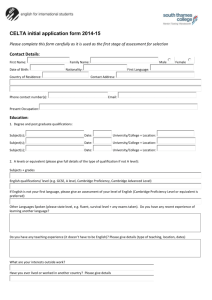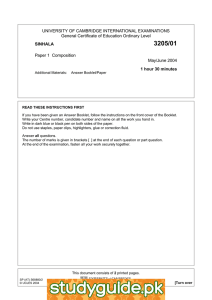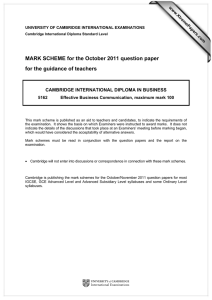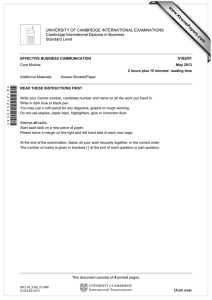MARK SCHEME for the May 2013 series www.XtremePapers.com
advertisement
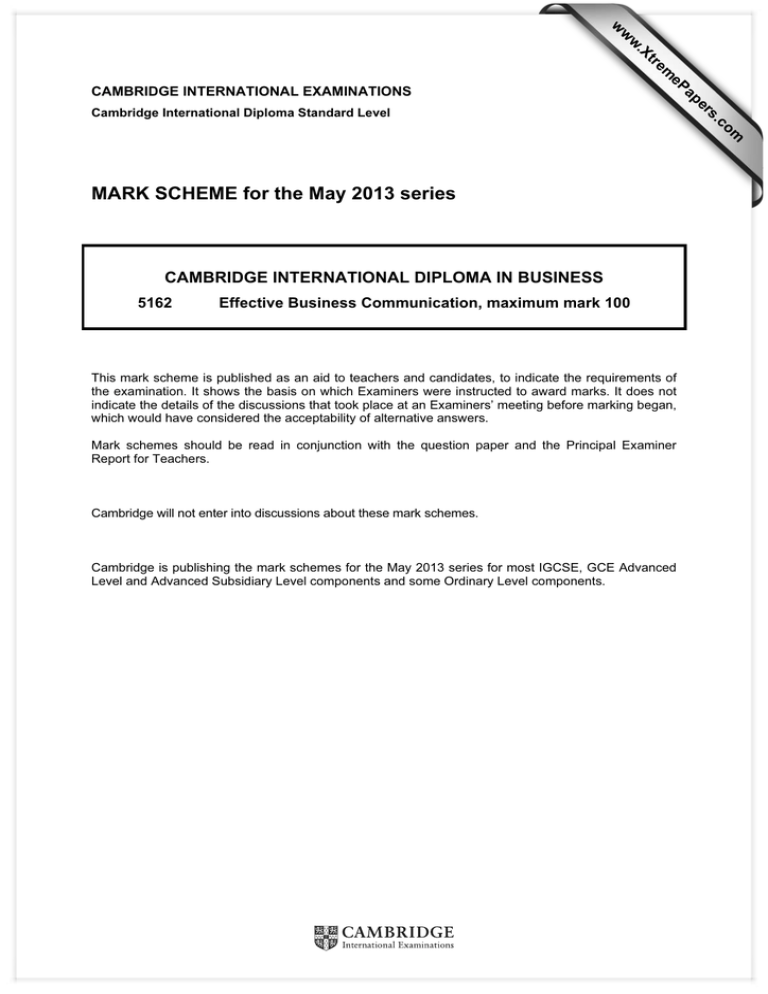
w w ap eP m e tr .X w CAMBRIDGE INTERNATIONAL EXAMINATIONS om .c s er Cambridge International Diploma Standard Level MARK SCHEME for the May 2013 series CAMBRIDGE INTERNATIONAL DIPLOMA IN BUSINESS 5162 Effective Business Communication, maximum mark 100 This mark scheme is published as an aid to teachers and candidates, to indicate the requirements of the examination. It shows the basis on which Examiners were instructed to award marks. It does not indicate the details of the discussions that took place at an Examiners’ meeting before marking began, which would have considered the acceptability of alternative answers. Mark schemes should be read in conjunction with the question paper and the Principal Examiner Report for Teachers. Cambridge will not enter into discussions about these mark schemes. Cambridge is publishing the mark schemes for the May 2013 series for most IGCSE, GCE Advanced Level and Advanced Subsidiary Level components and some Ordinary Level components. Page 2 1 Mark Scheme Cambridge International Diploma – May 2013 Syllabus 5162 Banu is concerned that, as the company grows, business communication must be maintained. (a) Identify three reasons why communication is so necessary in business. • • • [3 × 2 = 6] Communication is necessary for a business to operate successfully in today’s increasingly globalised world. Business needs to convey clear messages both within the organisation and to the outside business world. Businesses need to receive and process information effectively. (b) Suggest four reasons why it is important for VFS to communicate with all of its stakeholders. [4 × 2 = 8] • • • • • Shareholders – the future of the company and payment of dividends Customers – value for money, up-to-date fashions, feedback from customers Suppliers/manufacturers – to be paid on time, continuation of work, feedback on work produced Employees – working conditions, future of the company, systems and procedures Financial and Government Institutions Effective and efficient use of information, determining the needs of customers and responding to those needs. (c) When they sell the fashion items, the sales assistants use a combination of questioning techniques. Explain what is meant by the following types of question and give an example of each type: (i) open question [3] An open question allows the assistant to enquire in detail about the needs of the customer. For example “are you buying this outfit for a special event?” Gives the customer a chance to discuss the event for which the item is being bought for. Also provides the opportunity for additional sales for example shoes, tie or hat. (ii) closed question [3] A closed question is about gaining information without detailed discussion. Are you paying cash or by credit card? Are the sleeves too long? [Total: 20] © Cambridge International Examinations 2013 Page 3 2 Mark Scheme Cambridge International Diploma – May 2013 Syllabus 5162 Banu has now completed all the preparations for the Skype meeting. (a) Write a letter to the chosen manufacturer, Adam Smith, asking them to take part in the Skype meeting. Use information from the case study and create any other necessary details. [12] The letter should conform to the following format: • Logo or letter heading of the company – Delhi, India (1) • Date (1) • Reference – title (1) • Name and address of Adam Smith (1) to still give a mark if name is missing for this standard level • Appropriate salutation – Dear Mr Smith (personalised for the manufacturer) or first name Dear Adam (1) • The content of the letter – to include the time and date of meeting (Thursday 13 June at 10am (GMT) (2). An agenda, (1) confirmation of their attendance at the meeting and reason for meeting (2). (up to 5 marks) • Appropriate closure (1) • Yours sincerely and signature of Banu Aslan (1) (b) This will be the first time that the company has used Skype for a meeting. (i) List three advantages of Skype. • • • • • See face to face Instant feedback Cheap – no travelling and cost of calls Information at hand for the meeting Show presentations etc. (ii) List three disadvantages of Skype. • • • • • • [3] [3] The need for compatible software Internet connection is slow and you use it to make voice calls; could be delays and the sound may not be very good Interference whilst making calls Security issues The need for a webcam and microphone Cost of three way calling and to landlines (c) Identify two security measures which may be needed whilst using Skype. [2 × 1 = 2] Passwords Encryption when sending files etc. Virus protection [Total: 20] © Cambridge International Examinations 2013 Page 4 3 Mark Scheme Cambridge International Diploma – May 2013 Syllabus 5162 During the Skype meeting, the manufacturers will work in groups when planning the use of Egyptian cotton. (a) Give three reasons why groups are formed in business organisations. [3 × 1 = 3] Sense of belonging Common goals Shared workplace (b) Suggest four factors that may affect how the manufacturers work together as a team when they are planning the use of Egyptian cotton. [4 × 2 = 8] • • • • • • Size of group Group culture Relationships within the group Group process Expectation of the group Expectations of the individuals within the group 2 marks per point – 1 mark for identification and 1 mark for elaboration (c) List three types of business meeting. • • • • • • [3 × 1 = 3] Regular meetings – bringing participants together more than once (team meetings) (1) Company Directors’ meetings (1) One-off meetings (1) – asking for a quote or estimate Information-giving Information-taking Problem-solving (d) Identify three forms of non-verbal communication and three forms of verbal communication that should be avoided if the Skype meeting is going to be a success. [6 × 1 = 6] Three types of non-verbal communication – could be poor use of facial expressions and gestures, e.g. staring or glaring, poor eye contact, folded arms, hands behind the head, finger pointing. Three types of verbal communication to be avoided – shouting, raising of voice, use of bad language, general rudeness. 1 mark per point. [Total: 20] © Cambridge International Examinations 2013 Page 5 4 Mark Scheme Cambridge International Diploma – May 2013 Syllabus 5162 There has been considerable interest in the recruitment advertisement for buyers in Egypt. (a) Identify four purposes of holding selection interviews for the new team of buyers. [4 × 1 = 4] • • • • • • • To identify the personal characteristics of the person being interviewed To assess the interview skills versus those required for the job To enable the interviewee to ask questions about the company To tell the interviewee about the company To assess if the interviewee will fit into the company – has the right personality traits and skills To determine if the interviewee can be punctual To obtain information from interviewee (b) Explain the meaning of each of the following: (i) Semi-structured interviews [3] A semi-structured interview includes some major questions and follow-up planned and framed prior to the interview. Mainly used for selection interviews. (ii) Non-structured interviews [3] Non-structured interviews have no pre-arranged schedule or pre-prepared questions, it is based upon what happens on the day. (c) Write a set of selection guidelines to help with the recruitment of the new buyers in Egypt. [10] The guidelines for planning the interview should include the following: • Decide who should be present on the interview panel (1) • Decide on the types of questions, open, closed, scenario or leading (2) • Determine how the two-way flow of information should take place (1) • Determine how the interviewer should set the tone for the interview (1) • The importance of listening carefully and recording relevant information (1) • How to make notes at critical times during the interview, and identify any forms that may need to be completed (1) • How to make follow up notes after the interview (1) • How to determine who to accept for the role and how to write acceptance and rejection letters appropriately (2) [Total: 20] © Cambridge International Examinations 2013 Page 6 5 Mark Scheme Cambridge International Diploma – May 2013 Syllabus 5162 Banu is now preparing for the training session and presentation for the Skype meeting. (a) Explain why organisation charts help stakeholders to understand organisational structures. [5] Show the levels of authority and responsibility within an organisation The lines of formal communication The status and role of employees Level 1 – A list of points with no elaboration Level 2 – A brief explanation of a minimum of two of the above (1–2 marks) (3–5 marks) (b) Explain the purpose and benefit of using a flow chart to show the manufacturers how the company’s administrative procedures work. [5] Use of flow charts (activity charts) to plot various operations of a system giving a graphical picture of the steps and sequences of a procedure. Level 1 – A list of points with no elaboration Level 2 – A brief explanation of the above (1–2 marks) (3–5 marks) (c) Explain two ways in which multimedia aids would improve the presentation. [2 × 2 = 4] Sound cards Video clips Graphics Computer software e.g. PowerPoint, Excel, Word, Access Slide-based presentations (d) List six headings found in a formal report. [6 × 1 = 6] Title Introduction Findings and results Conclusion Recommendation Appendix To From Date [Total: 20] © Cambridge International Examinations 2013
